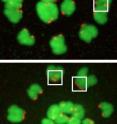Why the biological clock? Penn study says aging reduces centromere cohesion, disrupts reproduction
University of Pennsylvania biologists studying human reproduction have identified what is likely the major contributing factor to the maternal age-associated increase in aneuploidy, the term for an abnormal number of chromosomes during reproductive cell division. Using naturally aging mouse models, researchers showed that this basic fact of reproductive life is most likely caused by weakened chromosome cohesion. Older oocytes, or egg cells, have dramatically reduced amounts of a protein, REC8, that is essential for chromosomes to segregate correctly during the process that forms an egg. Mistakes in this process can create chromosomal abnormalities like Down syndrome.
Richard Schultz, associate dean for the natural sciences and the Charles and William L. Day Distinguished Professor of Biology in Penn's School of Arts and Sciences, and Michael Lampson, assistant professor of biology, found that kinetochores — the protein structures that mark the site where a chromosome pair is split during cell division — are farther apart in eggs obtained from aged mice, resulting in reduced centromere cohesion. Because cohesion in these cells is established during fetal development, and must remain functional until meiotic resumption in adult life (up to ~50 years later in humans or 15 months in mice), defective cohesion is a good candidate for a process that might fail with increasing maternal age.
Researchers demonstrated that about 90 percent of age-related aneuploidies are best explained by weakened centromere cohesion. Together, these results show that the maternal age-associated increase in aneuploidy is often due to a failure to effectively replace cohesin proteins lost during aging.
"Despite the well understood nature of the issue — popularly called the biological clock — the molecular mechanisms that underpin this phenomenon have never been fully understood," Schultz said. "Even now at the molecular level, there is no clear explanation for the loss of cohesion, in large part because almost nothing is known about how cohesion is normally maintained during the long prophase arrest in mammalian oocytes. Outstanding questions, such as the stability of cohesin complexes on chromosomes during arrest and whether new cohesins load and mature during the arrest, are now under investigation."
To test whether cohesion defects led to the observed aneuploidies, scientists monitored chromosome segregation during the initial stages of separation, called the anaphase, in live mouse oocytes, counting the chromosomes in the resulting metaphase II eggs.
Researchers arrived at this hypothesis by identifying mRNAs that differed in oocytes of old and young mice, which suggested the spindle assembly checkpoint, kinetochore function and spindle assembly as processes that might become defective with age. Results of experiments addressed to test these possibilities suggested that they were unlikely causes. During these studies, however, the scientists noticed that sister kinetochores are farther apart in metaphase II eggs from older mice at 16 to 19 months of age compared to eggs from young mice of 6 to 14 weeks of age, a finding that drew their attention to explore reduced cohesion as a primary source for age-related aneuploidy.
